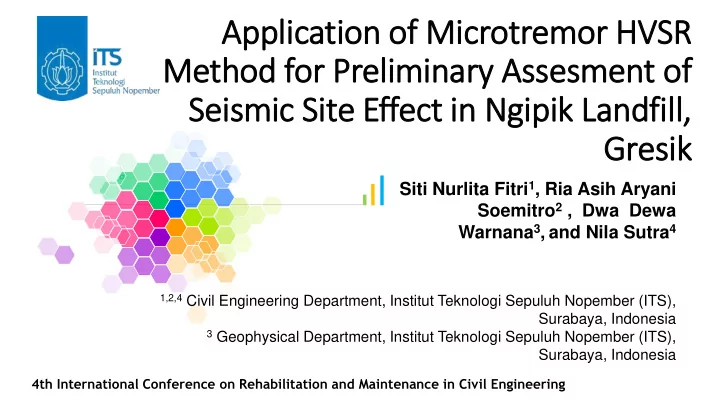

Application of Mic icrotremor HVSR Method for Preliminary ry Assesment of Seismic Sit ite Effect in in Ngipik Landfill, Gresik Siti Nurlita Fitri 1 , Ria Asih Aryani Soemitro 2 , Dwa Dewa Warnana 3 , and Nila Sutra 4 1,2,4 Civil Engineering Department, Institut Teknologi Sepuluh Nopember (ITS), Surabaya, Indonesia 3 Geophysical Department, Institut Teknologi Sepuluh Nopember (ITS), Surabaya, Indonesia 4th International Conference on Rehabilitation and Maintenance in Civil Engineering
INTRODUCTION • Gresik has several active seismic activities and active faults. • Geological conditions in Gresik consist of alluvial sedimentary, basin, limestone grumusol, red mediteran and sandstone with sediment in the form of limestone and clay 23km from 40km from 7/17/2018 Ngipik Ngipik
INTRODUCTION • The area of Ngipik Landfill is 6 hectares but the disposal zone area is around 4 hectares, and the height of the waste is about 10 and 12 m • It still use open dumping method for disposing the waste . • Leachate is a liquid that passes through refuse which has been extracted and suspended from the Topograpic Geological waste reaction and will Ground Motion contaminate the ground water amplification during Local site effect earthquake Geology subsurface’s assessment with geophysical surveying as though borehole method Microtremor Measurements analysis (HVSR Method) 7/17/2018
MATERIAL AND METHOD Geotechnical Investigation and Microtremor measurment • The soil characteristic was taken from 3 (three) boreholes (red dots) • The microtremor investigation was conducted on August 2017, on 25 x 25 m grid (white sign) and m easured for 30 minutes of ambient noise were recorded 1. filtered frekuensi about 0.2 and 25 Hz with 4 poles Butterworth filter 2. Time owned by each signal obtained 20 second length with cosine taper 5% 3. The FFT data has processed and smoothed by the Konno and Ohmachi (1998) method with (b=40) in each window. 4. HVSR Curve 7/17/2018
HVSR analyses from microtremor measurements has to satisfy the criteria defined by SESAME project 7/17/2018
Result and interpretation Distribution of predominant frequency (f 0 ) and Amplification factor (A m ) Predominant Frequency Amplification • The f o value represent the pattern of topographic area. The greater of depth of bedrock represent the smaller f o. The landfill’s height in northwest is the heighest, But he factors that may affect the factor f o is not the only one of topographic effect factor. • No correlation of Amplification and natural frequency. The soil depth not strongly controlled by variation of Am value. it can be concluded that the dominant factor controlled the Am variation is 7/17/2018 geological factors.
Result and interpretation Distribution of Soil Vulnerability Index (kg) 2 /F 0 Where : Kg= A m A m = Amplification F 0 = Natural frequency This method can be identified areas where greater seismic hazards and damage. The high value represent an indicator which could be helpful in choosing weak point of this area. The weak zone during earthquake and indicated the leachate’s Soil Vulnerability Index (Kg) spread due to ground motion of subsurface landfill. 7/17/2018
Conclusion • Microtremor and geotechnical measurement are generally employed for preliminary assessing site effect . Variation of soil subsurface properties and bedrock depth was provided to give initial information. Concurrently, the microtremor’s preparation and measurement are kept low due to no other active source is required. Hence, the microtremor HVSR method is very helpful to determined preliminary seismic microzonation in landfill. • The value of predominant frequency (f 0 ) between 1.1 and 3.65 Hz and peak of HVSR (A m ) varies from 2.04 to 7.16 and effecting to Vulnerability index (Kg) . Large values of Kg was found at Northwest; these zone were considered as weak zones and indicated the leachate spread . This result could be considered preliminary assessment the local site effects to rescirculation design of leachate. 7/17/2018
References 1. Nakamura, Y., Gurler, E.D., Saita, J., Rovelli, A., Donai. 12th WCEE in Auckland, NZ 2660/6/A (2000) 2. Agustina, Ummy Arofah., ITS Undergraduate Thesis of Environment Engineering (2013) 3. Warnana, D.D., Soemitro R.A.A., Utama, W. International Journal of Basic & Applied Sciences IJBAS-IJENS, 11 11 (2011) 4. Irsyam M., Widyantoro S., Meilano. I., Natawidjaja D.H., Budiono B., Triyoso W., Hendriyawan, Peta sumber dan bahaya gempa Indonesia tahun 2017 , ISBN 978-602-5489- 01-3 (2017) 5. Nakamura, Y., A, Quarterly Report of RTRI, Railway Technical Research Institute (RTRI), 1989, 30, No.1. 30 6. Nakamura, Y., Real Time Information Systems for Seismic Hazards Mitigation UrEDAS, HERAS, PIC, Quarterly Report of RTRI, 1996, 37 37, No. 3. 7. Nakamura, Y., World Congress on Railway Research in Florence, Italy, November, 1997. 8. Sutra N., Warnana, D.D., Soemitro R.A.A., Proceedings of Soft Soils (2016) 9. SESAME, Guidelines for the implementation of the H/V spectral ratio technique on ambient vibrations: measurements, processing and interpretation., 62 62 (2004). 10. Warnana, D.D., Soemitro R.A.A., Utama, W. Journal of Basic and Applied Scientific Research. 1(5) 412-417 (2011) 11. Yang Jun, Journal Geotech and Geoenvironmental Engineering, 132 132, (2006) 7/17/2018
Recommend
More recommend